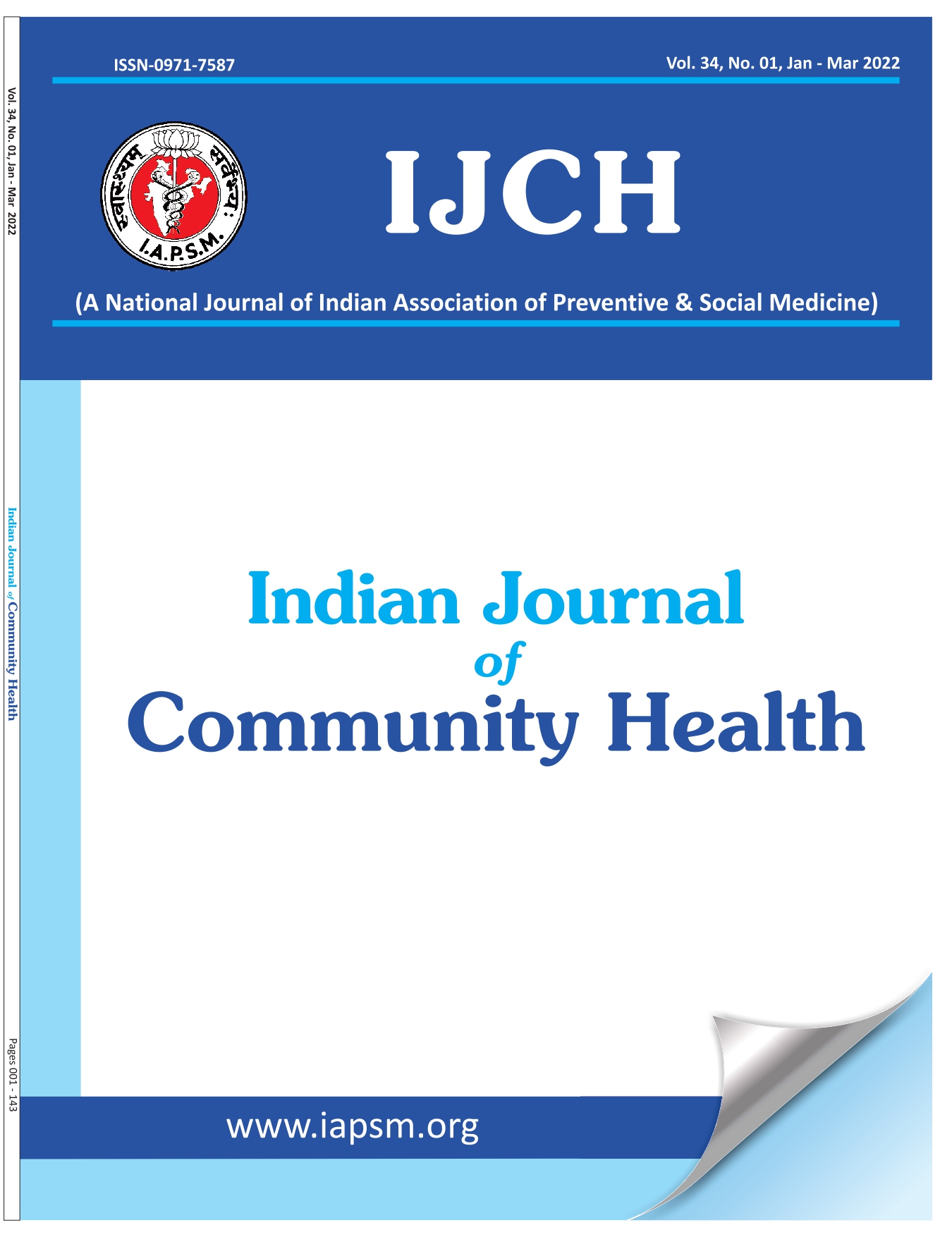Piecing the evidences: Barriers to utilization of Antenatal Care Services by Currently Married Women in Rural Uttarakhand- A community-based study
DOI:
https://doi.org/10.47203/IJCH.2020.v32i01.022Keywords:
Antenatal Care, Married Women, RuralAbstract
Background: High maternal mortality has always been an area of concern in developing countries. Availability and availment of adequate antenatal care play a significant role in reduction of maternal deaths. Aim & Objective: To know the extent of antenatal care (ANC) services utilization by the currently married women of rural Uttarakhand during their last pregnancy, to find the barriers for utilization of ANC services and correlate the socio-demographic variables with the non-utilization of ANC services. Methods and Material: This correlational study was conducted in rural areas of 3 randomly selected districts in Uttarakhand. Multistage stratified and simple random samplings were used for area selection and PPS technique was used to recruit the participants. Overall, 637 currently married women (CMW) who delivered in last 5 years prior to survey, were interviewed by trained social workers. Chi-square test was used to ascertain association between variables and regression analysis was done to adjust for confounding associations. Results: Overall 496 (77.9%) women availed one or more ANC services during their last pregnancy, but the complete package was availed by only 210 (33%) of the CMW. Majority of the women who did not avail any ANC services were older, illiterate, labourer, spouse of labourer/ unemployed person and belonged to lower socio-economic status. Unawareness was the most commonly cited reason for not availing ANC services followed by financial issues and unfelt need. Conclusions: Women in Uttarakhand are pliant to ANC services, but there is a need to create demand for it by increasing awareness and improving the quality of ANC services.
Downloads
References
Alkema L, Chou D, Hogan D, Zhang S, Moller A-B, Gemmill A, et al. Global, regional, and national levels and trends in maternal mortality between 1990 and 2015,. Lancet (London, England). 2016;387(10017):462–74.
Maternal mortality ratio (modeled estimate, per 100,000 live births) | Data [Internet]. [cited 2019 Sep 3]. Available from: https://data.worldbank.org/indicator/sh.sta.mmrt
Gülmezoglu AM, Lawrie TA, Hezelgrave N, Oladapo OT, Souza JP, Gielen M, et al. Interventions to Reduce Maternal and Newborn Morbidity and Mortality. In: Disease Control Priorities, Third Edition (Volume 2): Reproductive, Maternal, Newborn, and Child Health. The World Bank; 2016. p. 115–36.
Benova L, Tunçalp Ö, Moran AC, Campbell OMR. Not just a number: Examining coverage and content of antenatal care in low-income and middle-income countries. BMJ Glob Heal. 2018 Mar 1;3(2).
Lincetto O, Mothebesoane-Anoh S, Gomez P, Munjanja S. Antenatal Care. In: Lawn J KK, editor. Opportunities for Africa’s Newborns: practical data, policy and programmatic support for newborn care in Africa. WHO; 2006. p. 51–62.
International Institute for Population Sciences. NFHS-3: Summary of Findings [Internet]. [cited 2019 Sep 4]. Available from: http://rchiips.org/nfhs/NFHS-3 Data/VOL-1/ Summary of Findings (6868K).pdf
Health NF. National Family Health Survey (NFHS-4) 2015-16, Uttarakhand. 2018.
International Institute for Population Sciences. National Family Health Survey (NFHS-4) 2015-16 India [Internet]. International Institute for Population Sciences (IIPS) and ICF. 2017. Available from: http://rchiips.org/NFHS/NFHS-4Reports/India.pdf
Ghosh-Jerath S, Devasenapathy N, Singh A, Shankar A, Zodpey S. Ante natal care (ANC) utilization, dietary practices and nutritional outcomes in pregnant and recently delivered women in urban slums of Delhi, India: an exploratory cross-sectional study. Reprod Health. 2015 Mar 20;12(1).
Ravishankar AK, Rejoice PR. Differentials in Maternal Health Care Service Utilization: Comparative Study Between Tamilnadu and Karnataka. World Appl Sci J. 2011;14(11):1661–9.
Roy M, Mohan U, Singh S, Singh V, Srivastava A. Determinants of utilization of antenatal care services in rural Lucknow, India. J Fam Med Prim Care. 2013;2(1):55.
Nigeria. NIGERIA DEMOGRAPHIC AND HEALTH SURVEY 2013 National Population Commission Federal Republic of Nigeria Abuja. 2014.
Joshi C, Torvaldsen S, Hodgson R, Hayen A. Factors associated with the use and quality of antenatal care in Nepal: A population-based study using the demographic and health survey data. BMC Pregnancy Childbirth. 2014 Mar 3;14(1).
Srivastava A, Mahmood S, Mishra P, Shrotriya V. Correlates of maternal health care utilization in Rohilkhand Region, India. Ann Med Health Sci Res. 2014;4(3):417.
Tey NP, Lai SL. Correlates of and barriers to the utilization of health services for delivery in South Asia and Sub-Saharan Africa. Sci World J. 2013;2013.
Yar I, Said I, Yar IS. KNOWLEDGE AND BARRIERS IN UTILIZATION OF MATERNAL HEALTH CARE SERVICES IN KANO STATE, NORTHERN NIGERIA [Internet]. Vol. 1, European Journal of Biology and Medical Science Research. 2013 [cited 2019 Sep 4]. Available from: www.ea-journals.org
Fagbamigbe AF, Idemudia ES. Barriers to antenatal care use in Nigeria: Evidences from non-users and implications for maternal health programming. BMC Pregnancy Childbirth. 2015 Apr 17;15(1).
Downloads
Published
How to Cite
License
Copyright (c) 2020 Indian Journal of Community Health

This work is licensed under a Creative Commons Attribution-NonCommercial-NoDerivatives 4.0 International License.





